Political Savvy
Articles
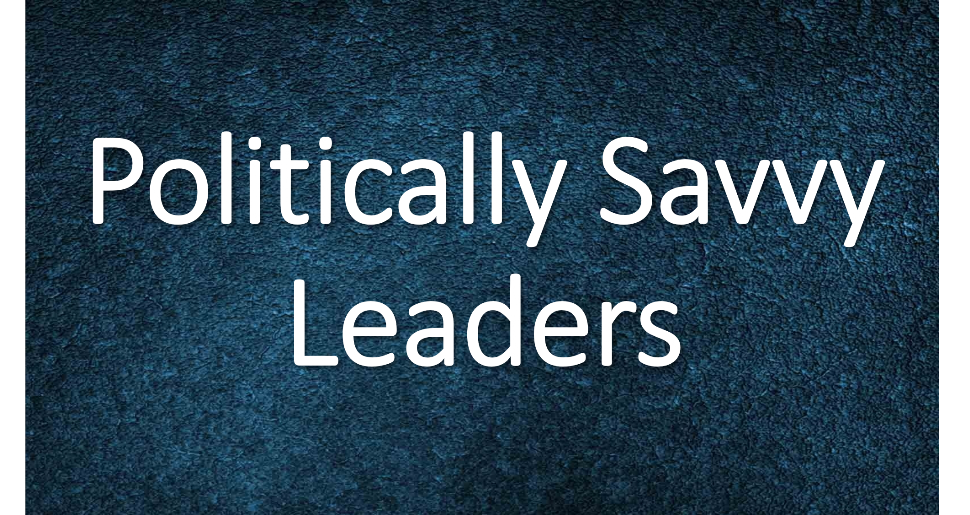
Politically Savvy Leaders
Frank Binnendyk
People have different meanings and interpretations for the phrases “political” and “political savvy” making them overloaded terms. In this article, we will distinguish their meaning and application as it applies to organizational leadership.
”Being Political’ often carries a bad reputation; it can conjure up images of backstabbing co-workers and up-and-comers who stop at nothing to get to the top. Their behavior appears unsavory at best and, at its worst, unprincipled, unethical and untrustworthy. The Machiavellian approach, marked by cunning, duplicity, or bad faith represents the low road of political savvy. Integrity marks the high road.
The “goodness” or “badness” of political savvy lies not in the wielding of influence, but in the motivation and the means to achieve an objective.

Politically aware individuals fall into two categories. Those who act with integrity, behave like the archetype of the wise owl while those who act with selfish motivations resemble the archetype of the wily fox, or snake in the grass. They’re cunning and untrustworthy. Similarly, there are two categories for the politically unaware. Those with selfish motivations come across as the inept donkey, while those who act with integrity resemble the archetypal innocent lamb who is at the mercy of those more politically astute.
“Politically savvy” leaders accept the fact that organizations represent a complex labyrinth of egos, issues, rivalries, sacred cows and personal sandboxes and deal effectively with them. Political savvy represents an essential part of being an effective leader, especially in larger organizations.
The politically savvy leader acts neither under political, like the good intentioned lamb that dutifully follows the heard, nor overly political like the game players out for their own interests.
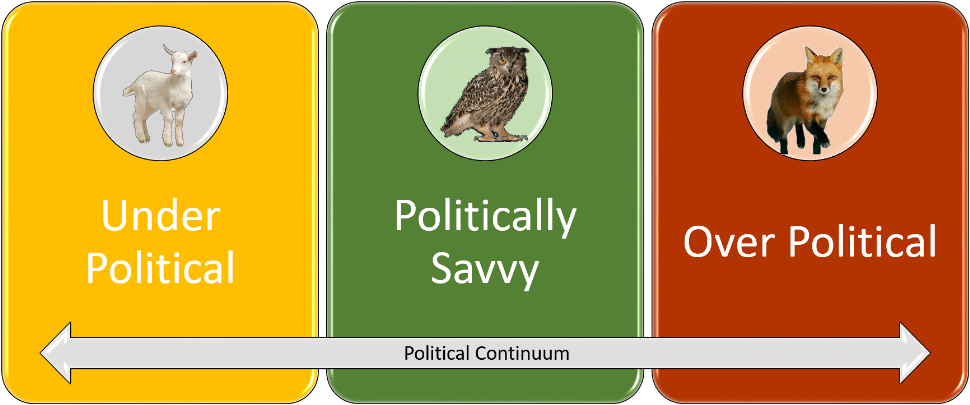
Key characteristics of the politically savvy leader include: operating with integrity, maintaining awareness, functioning proactively, protecting their assets and group.
The following diagram provides the structure for the rest of this article.
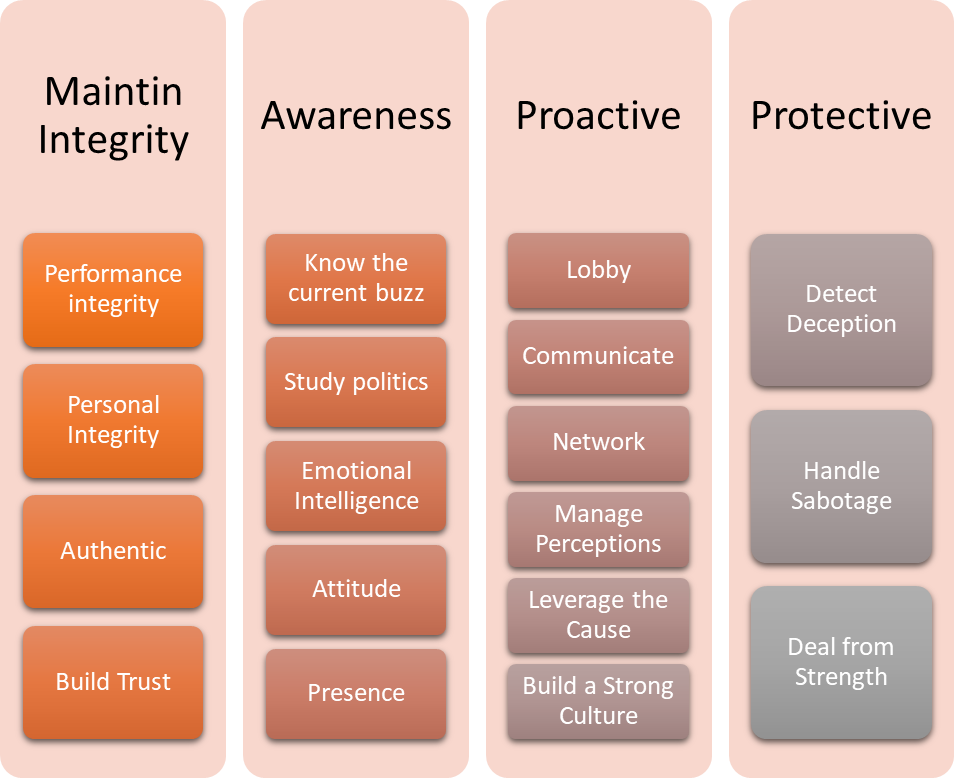
MAINTAIN INTEGRITY:
Maintain Integrity in the Performance of themselves and their teams
When you have performance integrity, you communicate what will do, do what you commit to and prove or demonstrate the results. Savvy leaders strive for clarity and alignment, especially within their chain of command.This means as a leader, you not only need to have it straight in your mind, you must also ensure that the rest of the organization articulates it the same as you.Define and report Key Performance Indicators (KPIs) to keep the process and work output on track. Ideally some of those KPIs provide an early warning when performance begins to drift and before it becomes a large problem. KPIs need to be both feasible and an effective measure.
Maintain Personal Integrity
Integrity forms the core of business leadership. The way you conduct yourself with respect to your word impacts how you show up as a leader.Webster’s Revised Unabridged Dictionary defines integrity as a Moral soundness; honesty; freedom from corrupting influence or motive; -- used especially with reference to the fulfillment of contracts, the discharge of agencies, trusts, and the like; uprightness; rectitude.An inextricably coupled link exists between leadership and integrity. Without integrity, leadership theories and practices fall flat. Integrity binds organizations together, forming the cornerstone of success. Dwight D. Eisenhower stated, “The supreme quality for a leader is unquestionable integrity.”Integrity really comes down to a yes or no question. You either have it or you don’t. If you don’t have it, then it acts like a poison in an organization causing it to fragment and splinter in dissention. The higher you ascend in an organization the more devastating the impact when you fail to operate in the space of integrity. Therefore, leaders must always display the highest levels of integrity.Leaders with integrity act sincere; their actions match their words. A single act of integrity makes a good impression, but a leader’s behavior must be consistent to be effective in motivating people to their maximum performance.To live in integrity:
- Say what you will do
- Do what you say
- Acknowledge and take responsibility for breakdowns (no excuses)
Other integrity-building suggestions include:
- Don't lie. Lying leads to a lack of integrity, even if "justified". Once labeled a liar, you will find it very difficult to project integrity.
- Don't exaggerate. Exaggeration represents another form of lying, although less malicious.
- Respond, don't react. Think before you speak or do; check yourself. Act with emotional intelligence and be aware of your effect on others. When you act on emotion, you may not always act in accordance with your beliefs and later regret the unintended consequences.
- Know your beliefs. Before you can act consistently with your beliefs, you must know what they are. Once you know them, declare them openly.
- Strive for long-term success. Do not let immediate gratification at the expense of long-term success tempt you. Always keep the big picture in your mind.
Sometimes “stuff happens” and we find ourselves out of integrity. Get back on track with the following 4 steps.
- Take responsibility for your words and actions
- Speak authentically, speak from the heart
- Repair the damage and make affected stakeholders whole
- Promise to not make the same breach in the future
To get a measure of your own integrity, pay attention to what you think and how you act when no one can observe you. Integrity can also be the promises you make and keep for yourself.
Be Authentic
Being an authentic savvy leader means being honest, open, trustworthy, consistent, and with good intentions.
Don’t attempt to be one way at work, while your “true” personality emerges outside of work. “Leadership” does not equal “Acting.” If you treat it like an act, don’t be shocked or confused when your employees don’t trust you, don’t like you, and can’t really wait to work elsewhere.
- Be self-aware and genuine. Be a self-actualized individual, aware of your strengths, limitations, and emotions. Show your real self to your followers. Act the same way in private and in public; don’t hide your mistakes or weaknesses out of fear of looking weak. We’re all on an endless journey and we all have room to improve.
- Be mission driven and focused on results. Put the mission and the goals of the organization ahead of your own self-interest. Do the job in pursuit of results, not for your own power, money or ego.
- Lead with your heart, not just your mind. Don’t be afraid to show your emotions and your vulnerability or to connect with your employees. This does not mean you need to be “soft.” In fact, communicating in a direct manner remains critical to successful outcomes, but it’s done with empathy. Directness without empathy presents as cruel.
- Focus on the long-term stakeholder interests. Realize that to nurture individuals and to nurture an organization requires hard work and patience, but the approach pays large dividends over time.
Don’t confuse being authentic with compartmentalization. When facing adversity consider compartmentalization as an effective strategy. Isolate issues from all other challenges you are dealing with. Apply extreme focus on each compartment, but only for a short period of time. Move forward in incremental steps and once you see progress, close that compartment and open the next one, and say no to things that do not deserve a compartment. Respond appropriately to the compartmentalized issue to get the results you need. All the while you are working on compartmentalized issues that require different approaches and solutions, engage with your authentic self. If you are inconsistent in your behavior and act like Dr Jekyll on one issue and Mr. Hyde on another, people will note the inconsistency and it will negatively impact trust.
Build Trust:
Trust forms the foundation for solid relationships. Trust as a concept covers a lot of territory. To understand and become trust worthy, let’s consider it in terms of foundational elements. If you wrote trust as an equation, it would be:

Notice that Risk resides in the denominator of the equation. If there’s little at Risk, then the other elements are not so critical. As Risk goes up in a relationship Trust becomes super relevant. Notice also that the numerator consists of two elements; Credibility and Empathy. Because of the multiplicative relationship between Credibility and Empathy, if either goes to zero, then trust goes to zero.
To better understand trust, let’s further break down the elements of credibility and empathy into subcomponents.
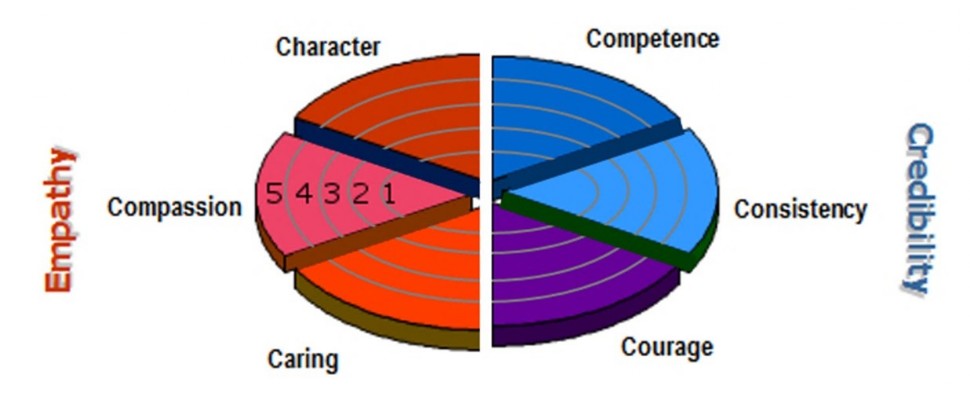
Credibility consists of competence, consistency, and courage. If you do not have the skills or training to be competent as a leader, then people’s trust in you to lead them becomes low.Competence addresses the question of whether you can lead your organization to success. You may be a competent leader, but if you behave or deliver inconsistently, then trust becomes an issue.Leadership Consistency addresses the question of whether you will respond predictably.The third element of credibility is courage. When we say courage in this context, we mean, “do you have the courage to try innovative ideas and to do the right thing even if it’s not popular?” If people question your willingness to step-up and act courageously, especially when the stakes become high, then trust becomes an issue.Empathy consists of caring, compassion and character. If you do not have others best interests at heart, then trust will diminish. Likewise, if you want to have a positive relationship with someone, then empathy needs to come through as part of your conversations. To demonstrate empathy, it’s necessary to let people know you care.Compassion at work includes being considerate of other people’s risk or pain. If they hurt, offer a heartfelt acknowledgement of that hurt. Expressing compassion involves being soft on the individual, even though you may need to be tough on the issue or their behavior.Your ability to keep a confidence impacts your Character as it relates to trust. It entails living your values and being truthful. For people to open-up in conversation, they need to know they’re safe when sharing a vulnerability. They need to feel you’re going to respect their disclosure and not cause them any future harm.
Methods to increase trust and the level of intimacy as a savvy leader include:
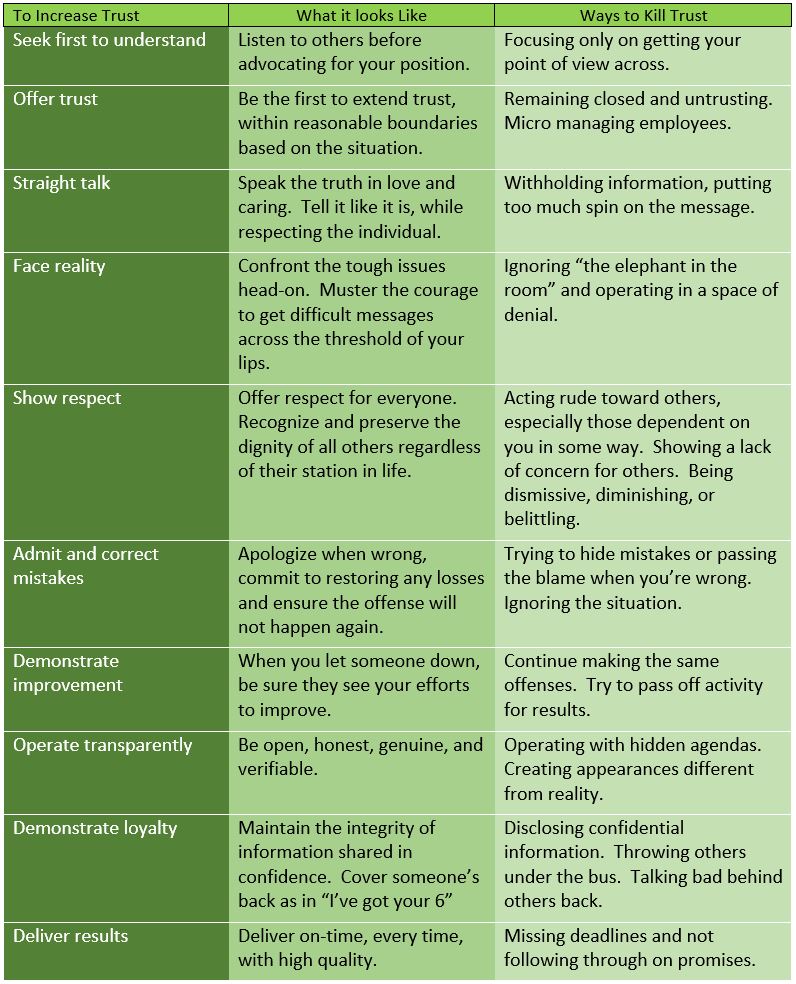
AWARENESS:
• Know the current buzz
Know the lay of the land and be able to read people's emotional states, willingness to interact, intentions and goals. Know who has influence and pull. Who do people respect, who has credibility and clout, who has visibility, who is valued, and who is in a position of strength to help sell your ideas. Know the views of these key players and how you might be able to help resolve their problems. Obtain social aptitude: network with key stakeholders. Find out about their needs, concerns, goals and where they’re at risk. Pre-contract with them whenever possible.
• Study politics
Organizations consist of power hierarchies. And from time to time, that power shifts. To succeed, you need to know where the leverage lies – who has influence (formal or informal), who doesn’t, and how much you have yourself. Politically savvy people always understand the current-status and recognize when it may be changing.
• Emotional Intelligence (EQ)
EQ includes the capability to recognize your own emotions and those of others, discern between different feelings and label them appropriately, use emotional information to guide your thinking and behavior, and manage and/or adjust your emotions to adapt to environments or achieve your goal(s)
• Choose your attitude
Choosing your attitude helps in sending the right signal in first interactions. It’s the attitude you choose that attracts people or has them fleeing as quickly as possible.Many people respond as if the events in their life dictate their attitude. If things do not go well, their attitude might be poor, then the poor attitude repels others and causes more things to go bad. It becomes a vicious cycle: the events of their life affect their attitude; their attitude gets a poor response from others; and this brings on more negative events in their life.Attitudes that repel include: arrogance, resentment, impatience, and hostility. If you’ve ever met someone with one of these attitudes you already know how unpleasant they can be to be around.In contrast, attitudes which build trust include: welcoming, empathy, resourcefulness, and curiosity. When you take on one of these attitudes your body language responds accordingly, people notice these cues and you get decidedly better outcomes.
• Presence
Your presences, demonstrated in the way you carry yourself, sends signals of authority and power. Great leaders intentionally choose their presence and how they show up. The military calls it command presence. It takes place when you walk into a room, office, or any situation and present yourself as someone in charge, even when not formally in charge.From a military or law enforcement perspective "Command presence," describes the physical component of how leaders lead: their body movements, tone of voice, the way they stand, how they make eye contact. "Chieftains must be credible. Their words and actions must be believable to both friend and foe. They must be trusted to have the intelligence and integrity to provide correct information. Leaders lacking in credibility will not gain proper influence and are to be hastily removed from positions of responsibility, for they cannot be trusted." -- Wess Roberts, “Leadership Secrets of Attila the Hun,”· Do you appear in control?· Do you have confidence in your ability to resolve the issue?· Do you act in control?· Do you speak in control?To demonstrate presence, know and state your opinions clearly, backing them with strong rationale. Don't take things personally. See business as business.
PROACTIVE:
• Lobbying
You influence the decisions made by other individuals by Lobbying.First, identify those individuals in the power base or who can influence decisions regarding your agenda.Lobbying represents a flow of conversation types, starting with Conversations for Relationship that build rapport and trust; followed by Conversations for Possibility to discover needs and explore options; transitioning to Conversations for Action to agree on terms and deliverables; and concluding with Conversations for Relationship to close on a good note and a bright future.
· Communications
To strengthen your position:
- Be attentive to others
- Adapt your language to your audience
- See other points of view
- Make your point by asking insightful questions
- Describe the big picture
- Avoid irrelevant details
- Listen attentively
- Keep conflict to a minimum
- Give others credit
Being decisive in the way you say things and getting to your point, rather than letting others direct you, creates clarity. It's the ability to explain your views in a way that makes others want to join your proposed course of action. You can do this by owning your message and using active voice followed by a strong rationale in a confident statement "I think we should do this for the following reason.” Repeat mission statements on a regular basis and insure those under your command can clearly articulate your mission and their role in making it a reality.
• Networking
Build a Strategic Relationship MapA strategic relationship map powerfully directs your networking efforts. A map consists of a spreadsheet that identifies all those who affect your success, including: bosses up the chain of command, peers, subordinates, stakeholders and customers.For all listed on your map, identify them by name, position, strategic importance, the status and the trend of the relationship (declining, static, improving). For those with a gap between the relationship importance and status;o Further define the importance of the relationshipo The reason for the gapo Spell out the current realityo Develop a plan to close the gapFor important relationships:o Further define where they’re a stakeholdero What’s at risk for themo What would be a win for them.Partner with your boss. Unless you have unique and irreplaceable knowledge or skills, your boss has more power than you do. Your boss also has greater access to key decision-makers. It’s better to have your boss as a cheerleader than an adversary. Politically savvy people know how to “manage up”. Gain the support of your boss by looking out for their best interests and avoid surprising them.People above your boss make big decisions about your career, so you need to be sure they know who you are. Since you may have limited access, look for interaction opportunities and be ready with a question to ask or information to share.Politically savvy people enjoy talking to folks who have power, without sucking up.Be a 360° team player. With a wide network of relationships, including your peers, you will have more information about what’s going on. You will produce better results when people willingly cooperate and collaborate with you. Politically savvy people develop positive relationships in all directions – with management, peers, and subordinates.Manage Perceptions. No one can appreciate you if they don’t know what you’re doing. But that doesn’t mean you should become an insufferable braggart. Find natural ways to mention achievements and challenges, like sending regular progress reports to your boss or chatting about your projects at lunch. Politically savvy people share information without being obnoxious.In most work environments, it’s up to you to toot your own horn from time to time. Especially when you’ve completed a task worthy of praise and your higher ups don’t even seem to notice.Unless your boss comes out and tells you you’ve done a good job, don’t just assume they’ve taken notice. Most workplaces become competitive. The higher you rise, the higher the skill level of your peers. Leaving your hard work unmentioned allows other similarly qualified peers to outshine you when they swoop in and reap the benefits of a boss who’s forced to take notice.“If you don't blow your own horn, someone else will use it as a spittoon.” ― Ken BlanchardLeverage the power of the cause.
Leadership takes passion, determination and skill. You can’t skip any of those three and expect to enjoy lasting success.Leaders who make large change happen, draw permission and inspiration to do their work by being accountable to their cause. The cause gives them charisma – it magnetizes and motivates them despite how they might feel about themselves at any given moment.When the cause has charisma, savvy leaders find themselves recruited to make it happen. They draw charisma from the cause. And when that happens, people show up to help. The attraction of being part of something worthy, far bigger than yourself creates a drive that leads to success.When you put together deep knowledge about a subject that intensely matters to you, charisma happens. You gain courage to share your passion and when you do that, people follow. This makes you a leader.
• Intention builds strong healthy culture.
Savvy Leaders intentionally build strong organizational cultures. In this context we define culture as the way we get things done around here. Savvy leaders recognize the measurable relationship between a strong culture and superior operational performance. You can have a great strategy, but without the culture to support the strategy, the strategy will never reach its potential. In short, culture eats strategy for breakfast!
According to Dr. Dan Denison, 12 traits define organizational culture and these fall into four categories: Mission, Consistency, Adaptability, and Involvement.
Be MISSION Focused1) Create a shared vision2) Set clear goals and objectives . . .3) . . .with strategic direction and intentMaintain CONSISTENTCY4) Define core values5) Develop organizational agreement6) Manage the coordination and organization-wide integration of business processes in a way that supports those valuesFoster ADAPTABLITY7) Keep a focus on customers and their changing needs8) Promote organizational learning9) Help create changeExpand Employee INVOLVEMENT10) Build teams11) Empower all your employees12) Develop their capabilities in line with your mission and values
All 12 of these traits are important. Overemphasizing or ignoring any one yields a lopsided leader and, eventually, affects the organization’s success
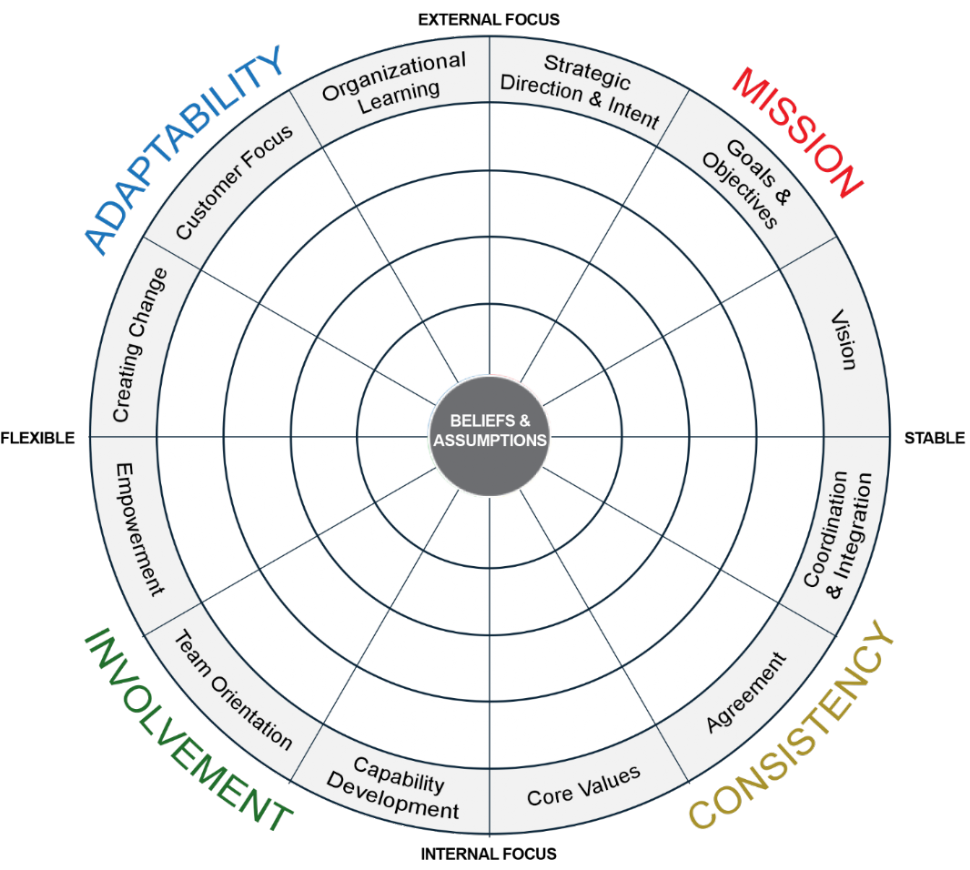
PROTECTIVE:
• Detect Deception
Many believe that deception, a traditional component of political and military conflict to be intrinsic to all human interaction.Deception depends on two criteria: first, it’s intentional; and, second, it’s designed to gain an advantage for the deceiver.Nature offers many examples of deception in the forms of concealment and activity designed to mislead. Protective coloration serves to protect some flora and fauna―either by making them difficult to see or by causing them to resemble something of little interest to predators. Some animals will feign injury to lure predators away from nests or offspring.Fabrication occurs when presenting false information as true.Manipulation, on the other hand, presents technically true information out of context to create a false implication. This deception may look like: leaving out information or associating valid information in such a way as to create false correlations.Preconceived ideas or simple prejudice often lead to the phenomenon known as “cognitive dissonance,” where you ignore vital information simply because it interferes with preexisting concepts or theories. The concept of “inertia of rest” refers to a tendency of people to believe certain assumptions remain valid even after shown as false.
“Knowledge is good” rings true regarding deception. The more you know about your adversaries and about the events as they unfold, the better prepared you will be to combat deception. Understanding your adversaries’ intentions and capabilities helps to define the general limits of their influence. Seek out multiple of sources of information or collection methods. The more sources you have, the more cross references you can make. The more you know, the more difficult it is for someone to manipulate information out of context. The more you know, the more likely you will detect a deception.
• Handle Sabotage
You can categorize Sabotoge in three ways:Situational: a specific situation or circumstance makes this person difficult. Stress becomes a huge factor with someone is situationally difficult. Find out what’s going on in his or her world professionally and personally that could impact their behavior.Intentional: some people believe that being unreasonable or mean results in effectiveness. Because no one has ever successfully stopped their behavior and they appear to get results, they feel vindicated.Ingrained: they have always been this way. Their ingrained behavior becomes a part of their personality. Only a life-changing event or therapy can correct this trait.
To deal with a saboteur:Don’t get angry: dealing with difficult people presents emotional challenges, so first take a deep breath and try to neutralize your emotions. Pause before responding and do not stoop to their level. The more you can get your emotions in check, the more control you possess.Confront the saboteur: Conduct a brief, pointed discussion with the saboteur. Ask why he or she chose to behave as such. You’ll get better results by being straightforward, direct and persistent.Go up another level or two: If your manager seems unconcerned regarding a workplace saboteur, go to his or her boss. Be careful not to complain how the sabotage affects you; rather address how it affects job production.Leave a paper trail: A paper trail of your work makes it harder for someone to claim a work idea/concept/project as his or her own. Make it a habit to archive relevant e-mails, documents and back up your databases, etc. so, in the case of controversy, you’re covered.
• Deal from Strength
Politically savvy people choose a career that they find interesting and energizing. You can’t fake enthusiasm for long. An indifferent, apathetic attitude never impressed anyone. If you want decision-makers to think well of you, you need to be interested in and excited about the business – because you can bet that they are!
As you read through the list below take note of where you rate yourself – 1 (low) to 5 (high) – on each of the following for statements
Maintain Integrity | |
I clearly state what I will do | 1 |
I do what I say on a regular basis | 1 |
I acknowledge and take responsibility for breakdowns (no excuses) | 1 |
I don't lie | 1 |
I don't exaggerate | 1 |
I respond, don't react | 1 |
I know and can articulate my beliefs | 1 |
I strive for long-term success | 1 |
When out of integrity, I take responsibility for my words and actions | 1 |
When out of integrity, I speak authentically, speak from the heart | 1 |
I repair the damage and make affected stakeholders whole when I compromise my integrity | 1 |
Each time I am out of integrity, I promise to not make the same breach in the future | 1 |
I listen to others before advocating for my position | 1 |
I am the first to extend trust, within reasonable boundaries based on the situation | 1 |
I speak the truth in love and caring. Tell it like it is, while respecting the individual | 1 |
I confront the tough issues head-on. Muster the courage to get difficult messages across the threshold of your lips | 1 |
I offer respect for everyone. Recognize and preserve the dignity of all others regardless of their station in life | 1 |
I apologize when wrong, commit to restoring any losses and ensure the offense will not happen again | 1 |
When I let someone down, be sure they see your efforts to improve | 1 |
I am open, honest, genuine, and verifiable | 1 |
I maintain the integrity of information shared in confidence | 1 |
I deliver on-time, every time, with high quality | 1 |
Maintain Awareness | |
I know the current buzz | 1 |
I study who has influence and how power shifts | 1 |
I am aware of emotions in myself and others and adjust my emotions to adapt to environments to achieve my goal(s) | 1 |
I choose my attitude before and during important interactions | 1 |
I send signals that I am an authority | 1 |
I intentionally look like I am in control | 1 |
I have confidence in my ability to resolve issues | 1 |
I intentionally act like I am in control | 1 |
I speak like I am in control | 1 |
Be Proactive | |
I Lobby individuals in the power base or who can influence decisions regarding my agenda | 1 |
I am attentive to others | 1 |
I adapt my language to my audience | 1 |
I see others' points of view | 1 |
I help make my point by asking insightful questions | 1 |
I provide the big picture, avoiding irrelevant details | 1 |
I listen attentively | 1 |
I give others credit to strengthen my position | 1 |
I keep conflict to a minimum | 1 |
I have a plan for building strategic relationships | 1 |
When I walk into a room, I know the key stake holders and their interests | 1 |
I intentionally build a strong healthy culture | 1 |
I create clarity and alignment around a shared vision | 1 |
I set clear goals and objectives | 1 |
My goals and objectives have clear strategic direction and intent | 1 |
I define core values | 1 |
I gain organizational agreement | 1 |
I manage the coordination and organization-wide integration of business processes in a way that supports values | 1 |
I keep a focus on customers and their changing needs | 1 |
I promote organizational learning | 1 |
I help create change | 1 |
I build teams | 1 |
I empower all my employees | 1 |
I develop my employee’s capabilities in line with my mission and values | 1 |
Be Protective | |
I quickly detect intentional deception designed to gain an advantage over me | 1 |
I spot sabotage early-on | 1 |
I distinguish between situational, intentional and in-grained sabotage | 1 |
When I spot sabotage, I remain calm and act appropriately | 1 |
I make it a point to deal from strength | 1 |
I leave appropriate paper or electronic trails | 1 |

